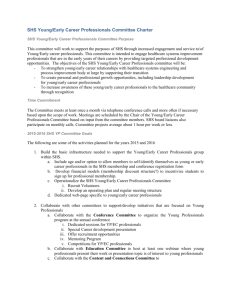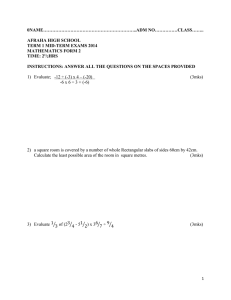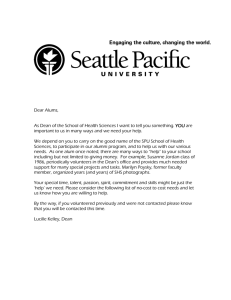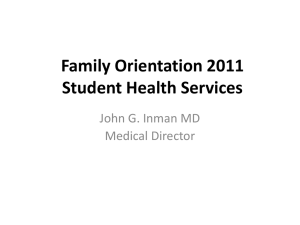Student Health Services 2013-2014 Annual Report July1-June 30
advertisement
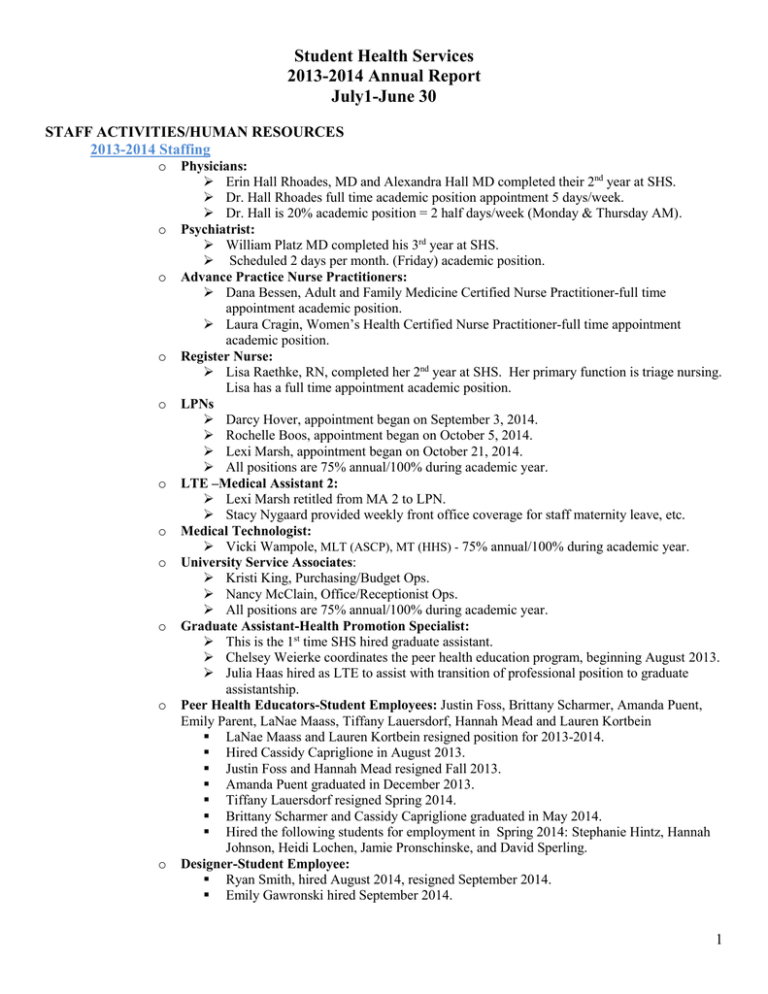
Student Health Services 2013-2014 Annual Report July1-June 30 STAFF ACTIVITIES/HUMAN RESOURCES 2013-2014 Staffing o o o o o o o o o o o Physicians: Erin Hall Rhoades, MD and Alexandra Hall MD completed their 2nd year at SHS. Dr. Hall Rhoades full time academic position appointment 5 days/week. Dr. Hall is 20% academic position = 2 half days/week (Monday & Thursday AM). Psychiatrist: William Platz MD completed his 3rd year at SHS. Scheduled 2 days per month. (Friday) academic position. Advance Practice Nurse Practitioners: Dana Bessen, Adult and Family Medicine Certified Nurse Practitioner-full time appointment academic position. Laura Cragin, Women’s Health Certified Nurse Practitioner-full time appointment academic position. Register Nurse: Lisa Raethke, RN, completed her 2nd year at SHS. Her primary function is triage nursing. Lisa has a full time appointment academic position. LPNs Darcy Hover, appointment began on September 3, 2014. Rochelle Boos, appointment began on October 5, 2014. Lexi Marsh, appointment began on October 21, 2014. All positions are 75% annual/100% during academic year. LTE –Medical Assistant 2: Lexi Marsh retitled from MA 2 to LPN. Stacy Nygaard provided weekly front office coverage for staff maternity leave, etc. Medical Technologist: Vicki Wampole, MLT (ASCP), MT (HHS) - 75% annual/100% during academic year. University Service Associates: Kristi King, Purchasing/Budget Ops. Nancy McClain, Office/Receptionist Ops. All positions are 75% annual/100% during academic year. Graduate Assistant-Health Promotion Specialist: This is the 1st time SHS hired graduate assistant. Chelsey Weierke coordinates the peer health education program, beginning August 2013. Julia Haas hired as LTE to assist with transition of professional position to graduate assistantship. Peer Health Educators-Student Employees: Justin Foss, Brittany Scharmer, Amanda Puent, Emily Parent, LaNae Maass, Tiffany Lauersdorf, Hannah Mead and Lauren Kortbein LaNae Maass and Lauren Kortbein resigned position for 2013-2014. Hired Cassidy Capriglione in August 2013. Justin Foss and Hannah Mead resigned Fall 2013. Amanda Puent graduated in December 2013. Tiffany Lauersdorf resigned Spring 2014. Brittany Scharmer and Cassidy Capriglione graduated in May 2014. Hired the following students for employment in Spring 2014: Stephanie Hintz, Hannah Johnson, Heidi Lochen, Jamie Pronschinske, and David Sperling. Designer-Student Employee: Ryan Smith, hired August 2014, resigned September 2014. Emily Gawronski hired September 2014. 1 Student Health Services 2013-2014 Annual Report July1-June 30 Search and Screen Committee o o License Practical Nurses: Recruitment for full time position occurred during the summer 2013. Darcy Hover, LPN and Rochelle Boos, LPN accepted position. LPN retitled from original hire of Medical Assistant 2 to LPN. Lexi Marsh, LPN. Summer Youth Camp Health Care o Stacy Nygaard, MA2, hired for summer camps June-August 2013. Staff Training and Continued Education SHS staff encouraged to participant in continuing education throughout the year via professional readings, attending conference, workshops, teleconference, webinars, etc. o All professional staff maintains current licensures and certifications in their select discipline (APNPs, RNs, LPN, and MDs). o Opening Week Annual Training: In house Confidentiality, Risk Exposure Plan, TB screening, AED, Fire Safety/Fire Evacuation, Severe Weather and Evacuation Blood borne Pathogen Training online conducted via Stericycle. N95Fit Testing. Point of care training provided by Vicki Wampole, MLT to APNPs, RNs, CMAs in the following areas: throat and UA culture set-ups, Clinitek UA dipsticks with the Clinitek Status, glucometer (Contour) and pregnancy testing. Point of care training provided by V. Wampole, MLT to APNPs in wet preps. o Tuition reimbursement for 3 credit course at 75% granted to Kristi King, University Services Associate spring 2014. She is pursuing BS in Health Information Management (HIM). OPERATIONAL AND PROGRAMMATIC Administration Highlights o o o SHS organizational chart was redefined-Appendix A Funding Model: SHS is funded through student segregated fees, fee for service billing and grant support. Health Fee for 2012-2013 4.28/credit = 132.20/15cr. 3% increase for 2013-2014 Approximately 97% of SHS expenses are personnel costs. The remaining expenses are largely made up of supplies, services and medications. Resurrected 3rd Party Insurance Billing progress: Insurance Contract Agreements: Anthem/Blue Cross-Blue Shield, Health Partners of WI, Humana, Medica, and WEA. Training for coding and billing set for August 2014, anticipating 3rd Party Billing to commence Fall Semester 2014. Electronic Medical Record (EMR) system unique to the provision of student health services and securing sensitive health information was implemented. Went “live” September 3, 2014. A team from UW Stout Information Technology supports the Point and Click electronic health record software, consults on new and modified operational and workflow procedures, addressees software and hardware issues, and maintains full utilization of the electronic health record systems. IT actively monitors the networks and systems for security threats and intrusions. Addition of medication dispensary module in 2nd semester Test and implement new releases of Point and Click electronic medical record software. Implement “self-check” Fall 2014. Received funding through student technology 2 Student Health Services 2013-2014 Annual Report July1-June 30 o o o fee. Student Health Insurance Plan: SHS increased its involvement in the selection of student health insurance plan. Quality plans remain an attractive option for students as emerging issues in family plans increase, i.e. high deductibles plans, loss of employer coverage, increase cost to insure young adults. Humana was selected as the student health insurance plan with annual premiums just below $1500 for students. Plan is Affordable Care Act compliant. Approximately 40 students enrolled for 2013-2014. Budget and Finance: Continued work with IT, Admissions, Bursar’s Office, Campus Card, Procurement Office, and Business Office for the following: student eligibility/distance learners, billing and cashiering, purchasing services, travel administration and grant administration support. Point and Click Software: eligibility, billing/billing statements, cashiering. Online Travel Administration. FPOS Grant processes. Insurance billing for students covered by student health insurance plan and international student plans. Shifted ordering of medical supplies/medications to RN. Policy Committee: The policy committee continues to meet to review, revise and develop policies and procedures for operations. Focus on subgroups, governance and emergency policies were the direction of the committee this year. This committee is aligned with the Accreditation and Association Ambulatory Health Care (AAAHC) standards Clinical/Medical Services Highlights UW Stout Student Health Services provides timely medical to minimize the impact of illness on the students’ academic pursuits. Students are able to access SHS within 24 hours for acute illnesses, and injuries. Students with ongoing medical needs, SHS provides continuity of care and coordinates specialist care within the community when needed. 40% of the UW-Stout students received medical services at SHS in 2013-2014. Medical services strive to provide the best care through continuous improvement processes. Improvement processes include audits to compare with best practice benchmarks, follow ups and clinicians attending educational activities. Explore the use of EMR to further enhance the ease by which students obtain care and services: self-check, web-based appointment scheduling, and disease management. ======================================================================= Total Visits: 5535 Total No Shows: 202 Total Cancels: 888 Unique Students: 3175 o Top 10 Diagnosis Contraceptive Management ▪ Routine Physical Exams Pharyngitis ▪ Sexually Transmissible Infection Screening Upper Respiratory Infection ▪ Depression Anxiety ▪ Sinusitis ================================================================================= o WINTERM Staffing: 1 clinician, 1medical support personnel, 1 office staff o Ongoing review of OTC offerings. Expanded internal condom dispensary to self-serve including variety of condoms, Eating Disorders: Expanded eating disorders treatment. Women’s Health: o Increase access to contraceptive services by separating the need for physical exam from the need for contraceptive prescriptions. o Ensured adherence with changing guidelines for pap screening. o Increase demand for long acting reversible contraception methods. (IUD/Nexplanons) o Discussion re: Elle. Beginning Fall 2014 offer Plan B and Elle for emergency contraception. 3 Student Health Services 2013-2014 Annual Report July1-June 30 Psychiatry Services-Offered 2 times a month at SHS. The Psychiatry Service is to provide routine and urgent psychiatric evaluation and treatment of UW Stout students; consult, collaborate and refer to other medical health staff internally and/or with select community providers. Summer Youth Camps: Continue to provide medical supervision of summer youth camps. Coverage is provided on site for youth participants in summer educational programs in accordance to DHS 175. Programs/Camps included 2 weeks TEACH, 3 weeks PreCollege and 4 weeks STEPS. Approximately 300 youth participated in residential programs/camps. Sports Medicine: Formalized relations for concussion clearance, sickle cell trait, and ferritin screenings. Transgender Care: Increase number of patients seeking care/guidance. Peer Health Education Highlights The Peer Health Education program completed its 10th year. Total cost of program for FY is just under $10,000. Approximately 97% of SHS expenses are personnel costs-student employment. The remaining expenses are largely made up of supplies. The wide range of programs and services includes sexual health, nutrition, yoga, stress management/mediation training, sleep management and healthy living. Programs and information are offered to students to review their personal habits and to improve their health or to address specific concerns. Peer Health Educators presented the majority of programs in the residence halls reaching over 500 students. Peers also sponsored and/or involved in campus-wide programs that reached over 1100 students. Staffed information tables at the Memorial Student Center and Commons. These events included “Monday Campaigns”, Food Safety and Health Services. o Peers are BACCHUS Certified Peer Educators. o Mandatory Weekly meetings held throughout the year. o Weekly meetings held with UCC Outreach Staff. Quality Improvement Quality management and improvement are reviewed monthly by the Quality Management and Improvement Committee for relevance, and alignment with quality guidelines, professional standards, and regulatory requirements. This committee is aligned with the Accreditation and Association Ambulatory Health Care (AAAHC) standards. o Ongoing department-based chart reviews and data analysis designed to identify SHS performance and opportunities for improvements. 2013-2014 Chart Reviews/Peer Reviews x 4. Documentation of allergy, medications listing matching health history form. Diagnosis and treatment of sinusitis Documentation of follow up on positive cases of chlamydia. o CLIA Inspection—10/216/2013. No deficiencies o Laboratory QA/QT All QA/QT activities completed and passed o Emergency Drills x 4 Hyperglycemic drill Emergency communication via bell Fire Evacuation x 2 o Decreased numbers and less concerning significant events reported this year. o QMI conducted 3 survey during the academic year Healthcare Personnel’s Perceptions of a Culture of Safety Findings: As an office, we achieved scores significantly above the national mean in 11 out of the 12 categories, a vast improvement from last year where we had 5 categories above the mean, 3 at the mean and 4 below the mean. We made gains in all categories except for Staff Training, which showed an 8 point decrease. Areas where we made the biggest gains were as follows: Office 4 Student Health Services 2013-2014 Annual Report July1-June 30 Processes and Standardization (31 point gain), Patient Safety and Quality Issues (25 point gain), Communication Openness (25 point gain) and Information Exchange with Other Settings (21 point gain). We are still lagging behind in Teamwork but had an improvement overall, moving up to 77% from 66% the previous year with the national mean being 82%. Discussion: We are striving to provide excellent and safe care to our patients and this is corroborated in the study. A limitation for this study overall is the changes in personnel between last year and this year. One of the biggest improvements we’ve made in terms of safety has been implementation of an electronic medical record. In last year’s study there were areas of concerns about quality and safety which were directly related to having paper charts. We continue to actively pursue a quality improvement agenda, evaluating significant events and making changes where necessary. Teamwork may build over time. Developing a culture where everyone is willing to help others is a goal which we will continue to work on. We may need to pursue team building activities or other activities to foster growth in this area. Student Health Services (SHS) Spring Patient Satisfaction Survey Findings: This was an overwhelmingly positive survey, even better than our 2013 Patient Satisfaction Survey. Our average overall patient satisfaction rate was 95.8%, up from 93% last year. We reached at least 91% for the Great/Good in all categories with the exception of “location”, and “collection of payment or money”. Our “staff positive rating” was very impressive, ranging from 96%-98.5%. Our highest cumulative satisfaction was in the “Facility” category – 100%! Students like our care, they like our building, they like the ease and convenience of getting in to be seen. Another interesting finding was that, although we tend to be a regional university, a full 75% of students stated that we were their usual source of health care, unchanged from last year. Our biggest gains were in “Time in waiting room” which improved from 85% to 98%, waiting for test results which jumped from 82% to 96% and there was a slight gain in the check-in and check-out categories, up 3% from last year. Our location was the lowest score of any in our survey. As we might imagine, North campus residents loved our location, South campus residents were less happy. Like last year there were some students who wanted expanded hours – either later in the day, weekends or while we are on break. 99% of students would refer friends to us, up from 96% last year – a truly amazing number in a patient satisfaction survey Student Learning Survey: Student Health launched a pilot study to measure whether students believe they learned something during their medical visits. Results: 100% of patients who filled out the questionnaire indicated that they learned something during their medical visit to UW-Stout SHS. A total of 209 surveys were returned. Of those surveys, there were 519 total responses to what students had learned. The most common thing that students learned was “something about symptom treatment or self-care” (128), followed by “something about my illness or medical condition” (113), “something about medications” (104). Less frequent responses were “something about my body” (86), “something about how to get medical care” (46) and “something about how medical offices work” (21). SHS Staff Identification Badge Study: Staff are required to wear ID badges during work hours/shift. First study revealed 50% of staff wore their ID badge. Second study revealed 75% of staff wore their ID badge. The study was conducted as a random study, data collected via visually by Erin Hall Rhoades. 5 Student Health Services 2013-2014 Annual Report July1-June 30 MARKETING AND CAMPUS HEALTH COMMUNICATIONS o o o o Hired a student designer/marketing specialist. Marketing and Communication included printed and electronic materials, student emails, social media and web communications. Highlights: Internal signage, flu shot campaign, wellness fair, and bulletin boards. STUDENT HEALTH 101: 38% of the student population accesses this material 86% of students polled responded that they learned something that they would apply to their daily life 47% of students polled responded that they had seen or read something in Student Health 101 that caused them to want to get involved on campus, ask for help, take advantage of campus resources, or otherwise improve their health. LTE hired to facilitate Social Media and electronic publications. ACADEMIC/CAMPUS AND COMMUNITY PARTNERSHIPS o ASLS Web Masters group –K King o Athletic Training Department – Erin Hall Rhoades, MD o Camps and Conferences Committee-J. Ramaeker o Campus Business Managers – J. Ramaeker, K. King o Chancellor’s Coalition on Alcohol and Other Drugs – J. Ramaeker, Erin Hall Rhoades, MD o Counsel on Veterans Services-J. Ramaeker o ImageNow Workflow Users Group-K. King o International Student Orientation-D. Bessen, L. Cragin o International Student Health Insurance-J. Ramaeker, Erin Hall Rhoades, MD o LBGQT Department-SHS Staff o Mayo Clinic Health System-Red Cedar Patient Advisory Committee-J. Ramaeker o Mayo Clinic Health System-Menomonie: Courtesy Privileges: E. Hall Rhoades, MD o New Student Orientation Sessions-SHS Staff o Student of Concern Assessment Team – J. Ramaeker o Tobacco Free Campus Committee-J. Ramaeker o Study Abroad Student Travel Advisory-L. Cragin o Student Health Insurance Plan-J Ramaeker, E. Hall Rhoades, MD o Student Life Services Weekly Meetings- J Ramaeker, E. Hall Rhoades o University Counseling Center- Erin Hall Rhoades, MD o Wellness Committee-J Ramaeker, Co-Chair Admissions Counselors SHS Orientation and Tour-SHS Staff Campus Engagement Sessions-SHS Staff Information meetings with the follow university departments/offices/community etc. University Counseling Center, meet & greet, Admissions and Counselors Multicultural Office TB Screening (QTB) International Students Collaborated with Athletic Department, specifically X County Coaches and student athletes screening ferritin levels. Collaborated with the Athletic Training Staff, specifically for Sickle Cell Anemia records/findings. Flu shots offered to students and campus community. Approximately 300 flu shots administered. All shots were given at SHS. Campus Wide Wellness Fair, held in Johnson Fieldhouse, April 2014. Over 700 attendees. Continued discussions with Vice Chancellor of Administration Services and Student Life re: mandatory health insurance. 6 Student Health Services 2013-2014 Annual Report July1-June 30 FACILITIES o o o o o o o o SHS consists of approximately 5500 square feet of 1st floor space. Began discussions and planning for SHS to become part of the Physical Education, Athletics, Recreation and Student Health Services building expansion. SSA supportive of SHS moving to the expansion/remodeling of facilities south of 13th avenue. Encourage movement of SHS to occur sooner than the 10 year plan. Held 2 facility emergency drills: Fire evacuation. Annual training on building evacuation, fire extinguisher use. Remodel of the front office. Move nursing office to 106 from 112. New computers were installed in all exam rooms for EMR. New Hematology analyzer for Laboratory. 7 Student Health Services 2013-2014 Annual Report July1-June 30 OUR MISSION TO YOU "The Student Health Services Staff at the University of Wisconsin-Stout is committed to promoting and maintaining a healthy campus community." 8


